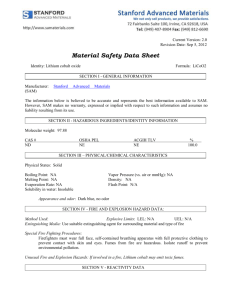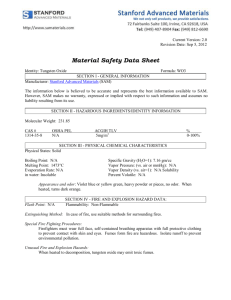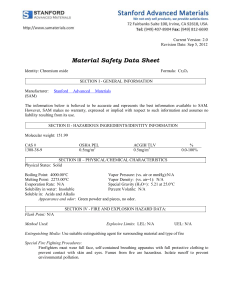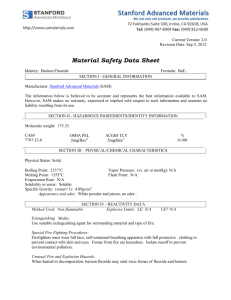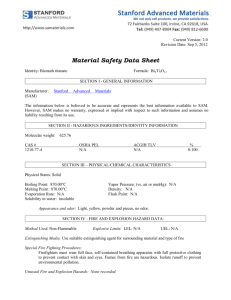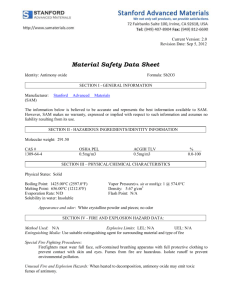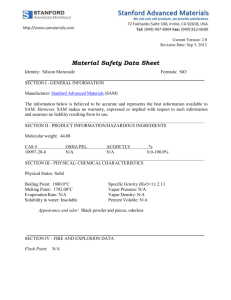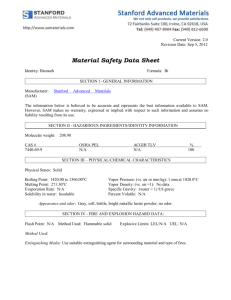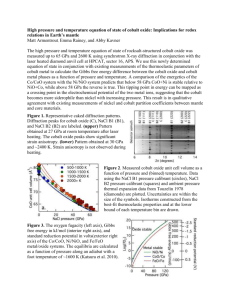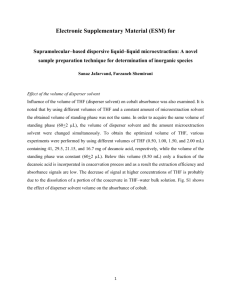Microsoft Word - CoO - Stanford Advanced Materials
advertisement
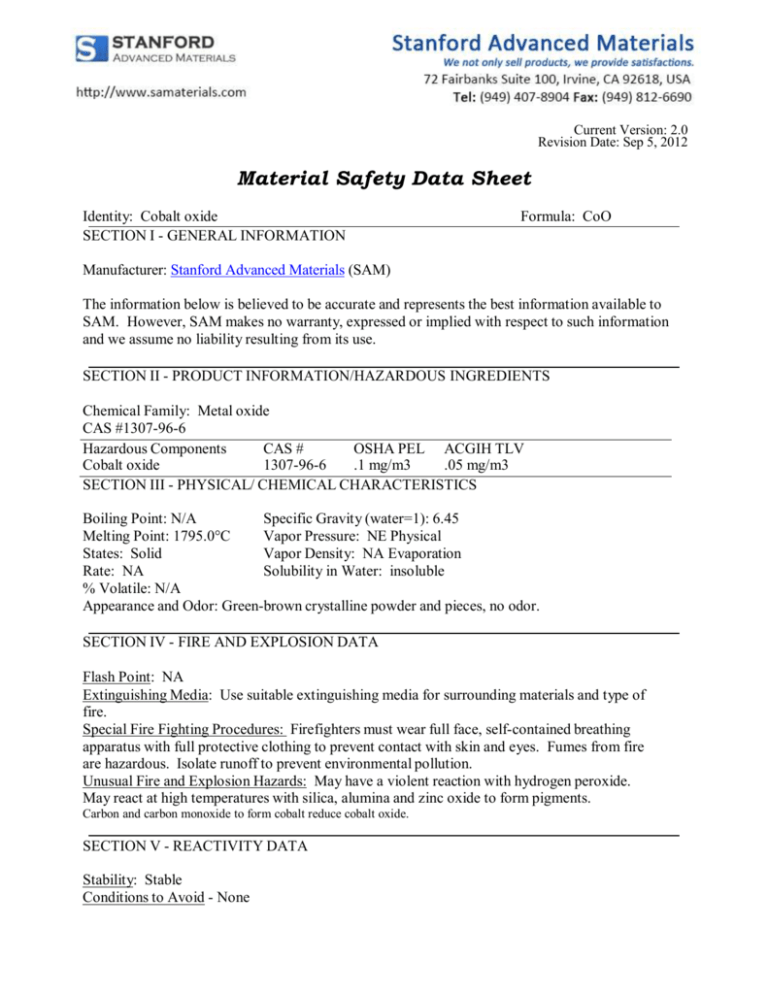
Current Version: 2.0 Revision Date: Sep 5, 2012 Material Safety Data Sheet Identity: Cobalt oxide SECTION I - GENERAL INFORMATION Formula: CoO Manufacturer: Stanford Advanced Materials (SAM) The information below is believed to be accurate and represents the best information available to SAM. However, SAM makes no warranty, expressed or implied with respect to such information and we assume no liability resulting from its use. SECTION II - PRODUCT INFORMATION/HAZARDOUS INGREDIENTS Chemical Family: Metal oxide CAS #1307-96-6 Hazardous Components CAS # OSHA PEL ACGIH TLV Cobalt oxide 1307-96-6 .1 mg/m3 .05 mg/m3 SECTION III - PHYSICAL/ CHEMICAL CHARACTERISTICS Boiling Point: N/A Specific Gravity (water=1): 6.45 Melting Point: 1795.0°C Vapor Pressure: NE Physical States: Solid Vapor Density: NA Evaporation Rate: NA Solubility in Water: insoluble % Volatile: N/A Appearance and Odor: Green-brown crystalline powder and pieces, no odor. SECTION IV - FIRE AND EXPLOSION DATA Flash Point: NA Extinguishing Media: Use suitable extinguishing media for surrounding materials and type of fire. Special Fire Fighting Procedures: Firefighters must wear full face, self-contained breathing apparatus with full protective clothing to prevent contact with skin and eyes. Fumes from fire are hazardous. Isolate runoff to prevent environmental pollution. Unusual Fire and Explosion Hazards: May have a violent reaction with hydrogen peroxide. May react at high temperatures with silica, alumina and zinc oxide to form pigments. Carbon and carbon monoxide to form cobalt reduce cobalt oxide. SECTION V - REACTIVITY DATA Stability: Stable Conditions to Avoid - None Incompatibility - Materials to avoid: Hydrogen peroxide, silica, alumina, zinc oxide, carbon and carbon monoxide. Hazardous Decomposition or byproducts: Cobalt Hazardous Polymerization: Will not occur. SECTION VI - HEALTH HAZARD DATA Routes of entry: Inhalation- Yes Skin - Yes Eyes - Yes Ingestion - Yes Other- N Health Hazards (Acute and Chronic): Cobalt has a low toxicity by ingestion. Ingestion of soluble salts, produces nausea and vomiting by local irritation. In animals, administration of cobalt salts produces and increase in the total red cell mass of the blood. In humans, a single case of poisoning with liver and kidney damage has been attributed to cobalt. Locally, cobalt has been shown to produce dermatitis and investigators have been able to demonstrate a hypersensitivity of the skin to cobalt. There have been reports of hematologic, digestive and pulmonary changes in humans. (Sax, Dangerous Properties of Industrial Materials, eighth edition) INHALATION: Acute: May cause irritation to the upper respiratory tract. Chronic: May cause permanent respiratory disease, occupational asthma and interstitual fibrosis. SKIN: Acute: May cause irritation Chronic: No chronic health effects recorded. INGESTION: Acute: Poison by ingestion, may cause acute cobalt poisoning. Chronic: No chronic health effects recorded. EYE: Acute: SEVERE IRRITANT AND CORRSIVE. Chronic: No chronic health effects recorded. TARGET ORGANS: May affect the respiratory and skin. Carcinogenity: NTP? Y IARC Monographs? Y OSHA Regulated? Y SIGNS AND SYMPTOMS OF EXPOSURE: Inhalation: May cause shortness of breath, coughing, wheezing, chest tightness and loss of weight. Ingestion: Acute cobalt poisoning may cause: nausea, vomiting, headaches, dizziness, diarrhea, lower blood pressure and body temperature. Skin: May cause redness, itching and inflammation. Eye: May cause redness, itching and watering. Medical Conditions Generally Aggravated by Exposure: Pre-existing respiratory or skin disorders. Emergency and First Aid Procedures: Ingestion: Give 1-2 glasses of milk or water and induce vomiting; seek medical attention. Never induce vomiting or give anything by mouth to an unconscious person. Skin Contact: Remove contaminated clothing; brush material off skin; wash affected area with mild soap and water; seek medical attention immediately. Eye Contact: Flush eyes with lukewarm water, lifting upper and lower eyelids, for at least 15 minutes. Seek medical attention. Inhalation: Remove to fresh air; keep warm and quiet; give oxygen if breathing is difficult and seek medical attention immediately. SECTION VII - PRECAUTIONS FOR SAFE HANDLING AND USE. Steps To Be Taken In Case Material Is Released or Spilled: Wear appropriate respiratory and protective equipment specified in section VIII-control measures. Isolate spill area and provide ventilation. Vacuum up spill using a high efficiency particulate absolute (HEPA) air filter and place in a closed container for proper disposal. Take care not to raise dust. Waste Disposal Method: Dispose of in accordance with local, state and federal regulations. Hazard Label Information: Store in tightly sealed container in a cool, dry area. Wash thoroughly after handling. SECTION VIII - CONTROL MEASURES Protective Equipment Summary-Hazard Label Information: NIOSH/MSHA approved respirator, impervious gloves, safety goggles, and clothes to prevent skin contact. Ventilation Requirements: Local Exhaust: To maintain concentration at or below PEL,TLV Mechanical: Not recommended Special: None Other: None Respiratory Protection (Specify Type): Use only NIOSH/MESA approved equipment – filter-dust, fume, and mist. Protective Gloves: butyl or polycarbonate gloves.. Eye/Face Protection: Safety glasses. Other Protective Equipment: Sufficient to prevent contact. Emergency eyewash and safety shower. Work/Hygienic/Maintenance Practices: Implement engineering and work practice controls to reduce and maintain concentration of exposure at low levels. Use good housekeeping and sanitation practices. Do not use tobacco or food in work area. Wash thoroughly before eating and smoking. Do not blow dust off clothing or skin with compressed air.
